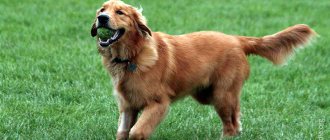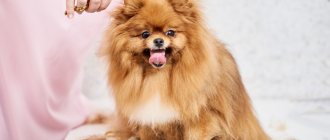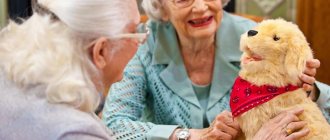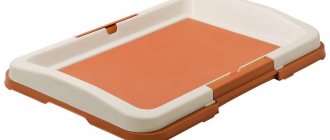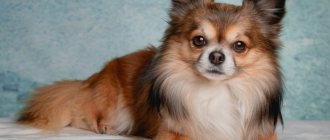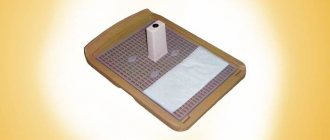The dog has been man's companion for about ten thousand years. All this time she was his guard, a faithful ally on the hunt, herded cattle and even nursed children. Human life changed, and with it the dog’s life. In today's fast-paced world, where everyone is on the run and there is a lack of live communication, the dog is given a new important role - a companion for humans.
What are companion dogs?
Some time ago there was an opinion that a dog should not live in a cramped apartment. And they didn’t want to let her into a private house. It was believed that a friend's place was on the street.
Over time, a person became more lonely and began to need a living being who would share his hobbies and who would need to be taken care of. What animals can be classified as companion dogs? Strictly speaking, any dog can become one. It all depends on what image is inherent in the owner and where he lives.
Of course, in a city, the easiest way is to live side by side with a small decorative breed dog. Let's look at the pros and cons of dogs of different sizes.
Purpose
The main purpose of companions is to share the interests of the owner: daily long runs through the forest, long car trips or lying on the sofa. Man and dog receive only positive emotions from communicating with each other. Dog therapy, also called canine therapy, is a method of alternative medicine. What health problems can you get rid of by communicating with a dog? Normalize blood pressure, cheer up, awaken interest in life - all this is possible for both a simple mongrel and a titled dog. Four-legged companions are widely used for the socialization and adaptation of children with autism.
The doors of the entertainment industry are opening to people with four-legged pets. Restaurants, fitness clubs, cinemas for visitors with animals are no longer uncommon.
Small dogs
Undoubtedly, it is most convenient to get a small dog. They are very easy to keep: they do not need long walks, frequent washing and large amounts of food. They are mobile; owners often appear with such dogs in stores, shopping centers and other places where dogs are prohibited from entering.
Although many do not consider such dogs to be full-fledged, they are man’s true friends and companions. They are loyal, love their owners and, despite their small size, are ready to defend themselves.
But there are also disadvantages. Of course, such a dog cannot be used as a full-fledged home guard. Keeping animals of this breed is quite expensive. This includes constant care and pickiness in choosing food. In addition, on the street such pets are often offended and injured by other dogs.
Is it possible?
You make the final choice yourself, so no one has the right to forbid you to adopt a Rottweiler, pit bull or hound. It is only important to note that in this case you cannot do without the help of a dog handler. All of the listed breeds have a complex character and are not ready to accept everyone as their owner.
Despite possible difficulties, timely socialization and competent upbringing of a puppy work wonders. “Difficult breeds” also become loyal and devoted friends, but require stricter control and mandatory obedience courses at a kennel club.
Do you like the article? 0
Medium size dogs
The advantage of such dogs is their life expectancy. It lasts longer than in small and large animals. Their medium size allows them to be a good defender of their owners, and not become a victim of attacks by most dogs on the street. As a general rule, medium-sized companion dogs get along well with children.
Cons : they require constant walking, frequent washing and constant grooming, and leave a lot of dirt in the home.
This doesn't mean that a large dog can't be great company. Even dogs that are commonly called fighting dogs can be suitable for this role. As a rule, large animals have developed zoo aggression. This means that you will additionally need to take training courses and constantly be on your toes to control your pet.
When choosing pets as companions, first of all, you need to take into account what other functions the breed will perform, whether there are children in the family, and suitable living conditions.
Pug
Bred in China, pugs were most likely used as royal gifts or barter not only in their homeland, but also in Tibet and Japan. This is how they appeared in Europe. Pugs need:
Space requirements are low. These dogs weigh no more than 8 kg (if you do not overfeed them) and grow up to 30 cm. Ideal for apartment life!
The need for training is low. Even though pugs may look like they've been hit by a door, they are very gentle and love to play with children. They are also stubborn. Seriously consider training if you don't want to see your Pug on the couch because he will insist.
The need for grooming is moderate. This is the drawback. They are a short-haired breed, so pugs do not shed much. However, you will need to clean your dog's wrinkles periodically to avoid irritation or inflammation.
The need for physical activity is quite low. You really don't have to do much training with this dog. Due to the special structure of their head and muzzle, pugs have very short airways. This means they have trouble breathing when overexerted and have difficulty controlling their body temperature (dogs do this by panting). Therefore, pugs are absolutely contraindicated for heavy physical activity and walks, during which they can become hot.
Disadvantages: Possible respiratory problems, hip displacement and encephalitis. In addition, pugs snore. Don't let them on your bed if you're a light sleeper.
For apartment
Living in apartments dictates its own rules for choosing a dog. After all, you will need to move with it around the entrance and yard, where a large number of people and dogs find themselves every day.
Requirements for a companion dog that will live in apartment conditions:
- Small or medium size;
- Calm temperament, with a weak guard instinct. A constantly barking companion dog, protecting its home from every rustle, will add problems in relations with neighbors;
- It is better to choose breeds of smooth-haired dogs.
In a small room, if one of the family members has allergies, you need to choose one that sheds little and does not have wings from which drool drips.
As a dog for apartment keeping we can recommend: Spitz, Jack Russell Terrier, Dachshund, Chinese Crested, Sheltie, Toy Terrier.
Japanese Chin
"Japanese Chin"
As a longtime companion of the Japanese royal family, these royalty are cute, fluffy lap dogs. Dogs of the Japanese Chin came to Japan from China, and for a long time only representatives of the nobility could have such a pocket dog and they were a certain status symbol. They are attached to their owner and find separation difficult. The average weight of the Japanese Chin is about 4 kg (ranges from 1.4 to 6.8 kg), and the height at the withers is 20-27 cm. Because of their short face, they can snore, wheeze, and even grunt, but unlike others small breeds (for example, Chihuahua), they very rarely bark, which can be a plus when choosing this decorative dog. The only downside to this breed may be that you will have to deal with the fact that they will always have better hair than you!
For the elderly
Older people are more likely than others to need a companion dog. But, even if the future owners are in good health, this can change at any moment. Then the pet will sit at home without a long walk. Without relieving his energy, he will begin to misbehave at home.
When choosing a dog for an elderly person, consider:
- the breed does not need much physical activity;
- the dog must have a good disposition and no aggression;
- The dog should love attention from humans.
The following breeds are suitable as dogs for an elderly person: Shih Tzu, Pekingese, Scotch Terriers, Miniature Poodle.
Russian Tsvetnaya lap dog
"Russian colored lapdog"
A cousin of the equally fluffy Bichon Frize, the Russian Tsvetnaya Bolonka is a breed of curious and intelligent dogs that were bred by St. Petersburg (Leningrad) breeders in the 1950s and are still popular in Russia. The height of these dogs reaches up to 26 cm at the withers, and the average weight can fluctuate between 3-4 kg. A distinctive feature of this breed is its colored coat, while most lapdogs have white fur. Russian colored lapdogs are curly-haired with a thick coat, somewhat similar to small sheep. Lapdogs are a typical representative of indoor sofa pets with a big loving heart. These amazingly loyal little ones will captivate anyone who meets them!
For a child
When choosing an animal that will become a child’s friend for many years, you should be especially attentive and careful. What is needed is a breed that can be a tireless companion in fun games, can become a guard and has a sufficient life expectancy.
In addition, such companion dogs must be devoid of aggression, both towards other animals and humans. A dog companion for a child should be a compromise between a playmate and a guard.
What is required from such a dog:
- Cheerful disposition and constant readiness to play;
- They love long walks. An additional bonus of having a dog will be the education of responsibility for a living creature.
The following breeds are recommended to keep a child company: Labrador, Giant Schnauzer, French Bulldog,
.
Yorkie-Poo
"Yorkie-Poo"
With the tiny stature of a Yorkshire Terrier and the intelligence of a Miniature Poodle, this playful, outgoing, energetic mixed breed dog makes the perfect family pet. The YorkiePoo breed is a designer breed of small dogs that was created by crossing two different purebred dogs - poodles and Yorkshire terriers. In addition to the above benefits, they can also be excellent watchdogs due to their devotion to their family. Plus, they are hypoallergenic! The average weight of these dogs is about 6 kg with an increase of 7 cm at the withers.
For security
Often a companion dog is left at home alone and is required to perform a guard function. In this case, it would be better to choose a large or medium breed dog. Such an animal should be family-oriented or one-owner, wary, but without causeless aggression, and treat strangers.
Most often, service dogs are adopted as guard dogs. When choosing an animal for protection, the owner must understand what he expects from the dog: a warning about danger or full-fledged security actions.
The breed must have:
- calm disposition, wary attitude towards strangers;
- unquestioning obedience to the owner, ability to learn;
- energetic temperament.
Recommended breeds: Shepherd dogs: Alabai, South Russian Shepherd, German Shepherd, Hungarian Shepherd, Airedale Terrier, Boxer, Doberman, Jack Russell Terrier.
Types of dogs for hunting
Today, many hunting breeds have been retrained as companions. Some dogs are really good as pets.
But no matter how friendly the animal is, it is worth remembering that its main passion is hunting. This is not a service or decorative pet. And he will constantly prove it.
Hunting dogs have the following traits:
- anger towards animals and friendliness towards people;
- stubbornness and personal opinion: when hunting, it is important to make your own decisions with lightning speed, and not wait for the owner’s command - the capture of game and the life of the pet depend on this quality;
- neutral attitude towards children and strangers.
There are 6 main groups of hunting dogs. They are divided according to the way they work.
Greyhounds.
Designed for hunting without a gun, mainly in open, easily visible areas. Their goal is to track, raise, catch and strangle the beast. The dogs have a relatively poor sense of smell, sharp eyesight and a lean body, allowing them to reach speeds of up to 70 km/h. They go with greyhounds to hunt fur-bearing animals, foxes, hares, and small ungulates. Popular breeds are Deerhound, Afghan Hound, Azawakh, Greyhound.
Hounds.
As is clear from the name of these hunting dogs, their purpose is to drive the animal: to bring it under the gun, drive it to greyhounds, or force it to hide in a hole, where terriers or dachshunds will continue the work. Hounds have a ringing voice with tints and yodels: it is used to determine what kind of prey the dogs have picked up and where it is located. The group is represented by the Beagle, Foxhound, and Rhodesian Ridgeback.
Burrows.
Created for hunting foxes, badgers, raccoons. They crush the animal in a hole, drive the hunter out of a hole, or drive it into a dead end - after which the person digs out a passage and finishes off the prey. These are the most fearless, stubborn and wayward breeds. The group includes dachshunds and numerous terriers.
Cops.
Bred for hunting game birds. Dogs have an excellent sense of smell - they search for birds in impassable swamps, endless fields and dense thickets. A characteristic feature of the group is the stance. When the dog approaches the prey, it freezes and sits up straight. Representing the Weimaraner, Breton Epagnole, Shorthaired Pointer, and Pointer sections.
Arms.
According to the method of work, they are close to cops. This group includes retrievers (golden, labrador, flat), spaniels and waterfowl dogs. Their task is to raise the bird under the gun, and then find and bring back dead game or wounded animals.
Likes.
Universal hunters. They are used to hunt large animals (bears, moose, wild boars), fur-bearing animals (foxes, weasels) and poultry. Huskies work equally well on any terrain. However, it is better to train a specific dog to bait a specific type of animal.
The best companion dogs
Despite the fact that each owner must choose companion dogs “for himself”, based on living conditions, there are breeds in the world that are considered the best universal dogs for company.
Let's list them:
- Poodle. These dogs are officially recognized as the smartest in the world. Kind, energetic, not picky about food. The poodle's coat requires special attention;
- Cocker spaniels. Medium sized dog, loves kids. Loves long walks;
- Collie. Very smart dogs, kind and affectionate. Convenient as companions for busy people;
- Labrador. The world's favorite dog. Versatile as companions. The breed does not bark much and loves children. But he will be an excellent companion for an elderly person. Due to its large size, it is difficult to keep in apartments. A large dog, but does not dominate the family and will accept a person of any character as a leader;
- Beagle. An excellent companion for a child. Not aggressive, very active and energetic. Training with such a dog is possible for a school-age child;
- Sheepdog. There are legends about the loyalty of the breed. It must be taken into account that she will choose one leader, and will consider the rest of the family members as a flock. She is ready to sacrifice her life to protect her family;
- Chinese Crested. Among small dogs, it is considered one of the best as a company dog. Although, it is not as common as other breeds. For example, Yorkshire Terrier. She is devoted to her owner all her life;
- French Bulldog. This breed is suitable for apartment living and gets along well with children.
Note that this list can be supplemented with many more breeds. After all, any dog can become a wonderful companion. This can be either a bull terrier or a huge cane corso. You just need to take a more responsible approach to his upbringing from the earliest days and take into account all the nuances of the breed.
If you don’t have confidence in your abilities yet, it’s better to choose a companion dog from categories that have enjoyed well-deserved fame in this field for many years.
Bottom line
We hope that this article will help you in choosing a companion dog for yourself. Don't forget that a dog is a man's friend. Think a hundred times before adopting a dog. So that later, due to lack of time, or an unsuitable lifestyle, you do not have to give it away.
Dogs understand everything and feel the same as we do, but they can’t say it.
Do you already have a four-legged friend? Or are you just planning to get a dog? If we missed something in the article, you can add it in the comments. We are interested in your opinion. You can post photos of your pets and talk about their antics.
Briefly about the main thing
- A dog for company should be chosen taking into account the living conditions of the future owner;
- It is better to choose small or medium-sized animals for your apartment;
- Energetic and non-aggressive breeds that love long walks are suitable for children;
- Elderly people need affectionate, non-aggressive dogs as companions;
- Medium or large-sized dogs are chosen as guards, seriously training the pet;
- There is a list of the best companion dogs. But he is conditional and any dog can become a companion for life.
List of breeds
Among modern dog breeds you can find many that fit the definition of a companion. How to make the final decision and make the right choice? Which dogs are the best among the small, medium and large varieties? A detailed review will help you figure it out.
Little ones
Not every small breed can be a good companion. However, there are decorative and simply compact dogs that easily find contact with humans. Among the leaders in the list of the most sociable kids in the dog world you can find these.
- Pugs. These charming homebodies are perfect for keeping in a city apartment; both children and pensioners adore them. The pet does not require complex care; it becomes very attached to its owner and shows miracles of good nature. With reasonable dietary restrictions, pugs are quite capable of living more than 15 years.
Sources:
https://kotsobaka.com/sobaki/porody-s/kompaniony.html https://www.adme.ru/zhizn-semya/10-luchshih-porod-sobak-dlya-semi-s-detmi-ne-samyj -ochevidnyj-vybor-2079665/ https://vplate.ru/sobaki/kompanony/

